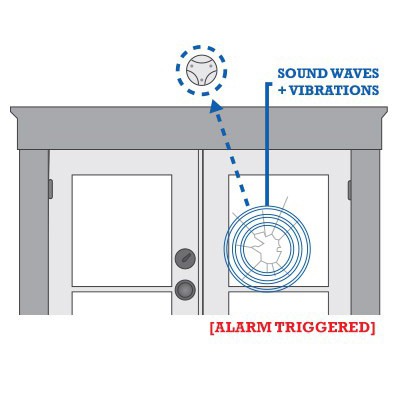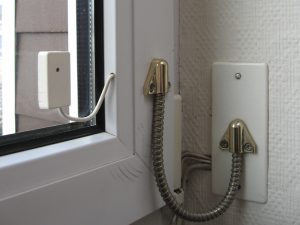
There are also door and window sensors that will sound an alarm when a burglar forces a door or a window open. But if he tries to open a window by smashing it – instead of prying it open – these sensors won’t trigger.
The only solution, therefore, is to get yourself a glass break detector. A glass break detector can detect even small breaks in glass so even if your security alarm or your door/window sensor fails to go off, the glass break detector will be the one to sound an alarm. The loud siren will scare off the intruders. Maybe you’d be better off by having all these kinds of alarms and detectors, right? You will have a back-up detector in case the others won’t sound their alarms.
So as the name implies, a glass break detector will only go off when the glass actually breaks. Now the problem is that you’re going to need one for every room – or at least for every area that needs extra protection, such as your daughter’s room or a room where all of your important stuff are kept.
There are three basic types of glass detectors: active detetors, acoustic detectors and physical detectors.
Active detectors:
An active detector sends out waves of energy towards the window pane, and receive it when reflected back. Provided that it receives back the same frequency of energy that it has sent out, it will remain quiet. But when a burglar smashes the glass, the energy that the detector gets back will be of the same frequency as the sound of the breaking glass, and the alarm will go off. Active detectors will remain armed any time, even when they’re in silent or “stay” mode.
 Acoustic detectors:
Acoustic detectors:
Unlike active detectors, acoustic detectors do not send waves of energy or anything like that. Instead, they relax, and wait around for a while until it detects a noise from a breaking glass. Acoustic detectors will sound an alarm even from a slight noise of a breaking glass. An electronical signal will be generated by the sound of glass breaking. The frequency of that signal will be the same as that of the breaking glass. So it creates a signal that does an impression of the breaking glass. This will then be compared with the standard glass breaking sounds that the manufacturer has programmed into the machine. If the electric signal frequency is similar as the pre-programmed breaking glass sounds, then the alarm goes off.
Physical detectors:
Physical detectors are similar to acoustic detectors in some ways, but not completely the same.
In this system, when the glass breaks there would be a sort of disturbance in the force. Or rather, there will be a disturbance in the molecules of the detector. This disturbance causes an electric signal to be created. That electric signal will then go to measure or analyze the sound of the breaking glass (or something like that). If the breaking glass that has occurred sounds like one of those pre-programmed breaking glass sounds that are already installed in the detector, then the alarm will go off.
Conclusion
Fortunately, most glass break detectors are now easier to install than ever. It won’t take even five minutes to set them up. It is best to install the detector on the wall beside the window, because the window will experience fluctuations in temperature. If the detector is placed straight on the glass window, it might render itself ineffective because of these temperature fluctuations. Besides, burglars won’t know that there’s a detector installed near the window.
If you want to provide your home complete protection against burglars and invaders, it is best to have three alarms: the security alarm, the door/window sensor and the glass break detector. You will have a back up in case any other alarms and detectors won’t go off.


 Acoustic detectors:
Acoustic detectors: